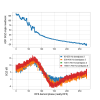Sheila, Camilla
We ran a couple of squeezing angle scans to check the settings of the ADF servo.
One thing that we realized is that the ADF Q demod signal is divided by H1:SQZ-ADF_OMC_TRANS_Q_NORM rather than mulitplied which is what we had thought. We changed the coefficent from 0.18 to 5.8. The first png attachment shows that this transforms the blue ellipse into the orange one. It would be a bit better if we first adjusted the demod phase to maximize the Q signal, so that the ellipse would be aligned along the axis, and the rescaled version would be more like a circle. However you can see in the right side plot that this gives us a reasonably linear readback of sqz angle as we change the RF6 demod angle (which is actually cabled up to RF3 phase) about 150 degrees where our best squeezing is.
Camilla turned the servo back on in sqzparams.
For future reference, a slightly better way to do this would be to move the demod phase to maximize Q, do a scan and set H1:SQZ-ADF_OMC_TRANS_Q_NORM to the ratio (max of Q)/ (max of I). Then you can do a smaller scan around the point with the best squeezing, and in sqzparams set sqz_ang_adjust_ang to the readback angle that you think is best.
This didn't work at the start of today's the lock as the ADF frequency had been left near 10kHz. Once I put the ADF back to 322Hz it seemed to work fine.
For operators, this means that if the squeezing looks bad, running SCAN_SQZANG_FDS alone won't change the SQZ angle. You would need to:
- Request SQZ_MANGER to SCAN_SQZANG_FDS
- Once it's done, if sqz has improved, adjust H1:SQZ-ADF_OMC_TRANS_PHASE to put H1:SQZ-ADF_OMC_TRANS_SQZ_ANG around zero.
- see the attached screenshot showing the channels to change and ndscope, this is from sitemap > sqz > sqz manager > ADF
- Request SQZ_MANGER to FREQ_DEP_SQZ
If the servo is running away, try the above instructions, if that doesn't work, the servo can be turned off via editing use_sqz_angle_adjust = False in sqz/h1/guardian/sqzparams.py. Please alog and tag SQZ.
Since we've had this servo running, the range has been higher and sqz more stable, see attached.




